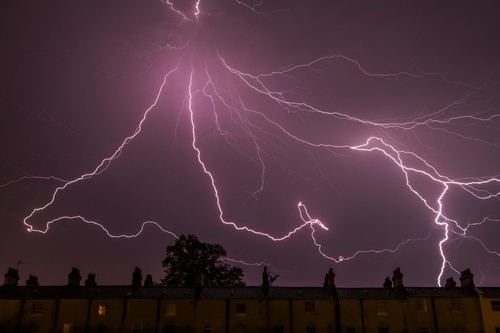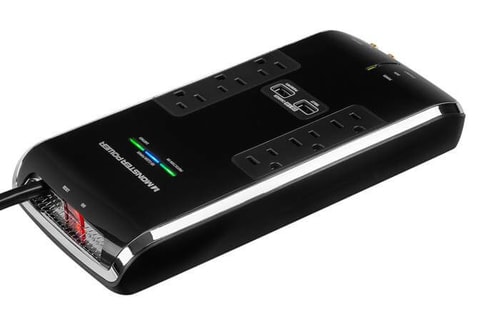
Power surges and spikes occur more often than you'd think. A common misconception is that they only happen during lightning storms. That's true, but surges can also be caused by electrical grid problems or a downed tree that hits a power line.
Power spikes are more common in homes. Similar to a surge but shorter, they occur from
appliances that demand a lot of power. Spikes are as dangerous as surges because they're loaded with thousands of volts.
Everyone owns appliances that can cause a spike at any moment. Depending on your home's wiring, the occurrence can be frequent.
Computers,
TVs, and
washing machines are all sensitive to voltage changes and can be damaged easily. They need to be protected, and aside from unplugging them, a surge protector is their only defense.
Power Strip vs. Surge Protector
When shopping for a
surge protector, it's important to choose a product that'll protect your equipment. There's a major difference between surge protectors and power strips; knowing what sets them apart will save you money if a surge occurs.
A power strip doesn't offer protection during a power fluctuation, even though most have a circuit breaker. The purpose of a power strip is to safely split a wall outlet into multiple plug receptacles; not to withstand the power or heat produced from a surge. In fact, they can potentially catch fire when a surge occurs.
A surge protector looks a lot like a power strip but is much more sophisticated. They must meet standards based on independent laboratory measurements for power dissipation and heat resistance. A surge protector diverts excess energy away from electronics by directing electricity to the grounding line, and the rest is dissipated as heat. Surge protectors also include inputs to protect cable, internet, and phone wires as well, because surges can happen on any power line.
 Features:
Features:
It's important that the product is UL 1449 Certified and states that it offers transient voltage surge or interrupter switch protection.
Here're some other features to consider and what they mean:
Warranties: A warranty will offer a certain amount of financial coverage if equipment is damaged while properly using the surge protector.
Automatic Warning Devices: Surge protectors don't last forever, and every surge decreases their lifespan. As a general rule, replace them every few years. Some products offer an audible tone or flashing light when the surge protector is no longer protecting the equipment.
Energy Absorption: This a number calculated in Joules and lets you know how big of a surge can be handled. When comparing, the higher this number, the better. Look for protectors with at least a 600 Joule rating.
3-Line Protection: This protects all power lines (hot, neutral, ground) because a surge can occur on any line.
Power Shut Down: This will shut down the power to all devices if a surge is detected.
GFCI: This feature will shut the power off if a short circuit is detected.
Cord Fire Protection: This will cut power to the unit if a sensor detects damage to the wire insulation.
Line Conditioner: This will smooth out voltage fluctuations to help your electronics' performance.
Protect Your Gear & Your Home
Surge protectors help prevent electrical fires and protect appliances and electronics. The cost of investing in a surge protector is easily outweighed by their necessity. Make adding one to your home a priority today!
See our full line of surge protectors and find one to best suit your needs.
 Power surges and spikes occur more often than you'd think. A common misconception is that they only happen during lightning storms. That's true, but surges can also be caused by electrical grid problems or a downed tree that hits a power line.
Power spikes are more common in homes. Similar to a surge but shorter, they occur from appliances that demand a lot of power. Spikes are as dangerous as surges because they're loaded with thousands of volts.
Everyone owns appliances that can cause a spike at any moment. Depending on your home's wiring, the occurrence can be frequent. Computers, TVs, and washing machines are all sensitive to voltage changes and can be damaged easily. They need to be protected, and aside from unplugging them, a surge protector is their only defense.
Power surges and spikes occur more often than you'd think. A common misconception is that they only happen during lightning storms. That's true, but surges can also be caused by electrical grid problems or a downed tree that hits a power line.
Power spikes are more common in homes. Similar to a surge but shorter, they occur from appliances that demand a lot of power. Spikes are as dangerous as surges because they're loaded with thousands of volts.
Everyone owns appliances that can cause a spike at any moment. Depending on your home's wiring, the occurrence can be frequent. Computers, TVs, and washing machines are all sensitive to voltage changes and can be damaged easily. They need to be protected, and aside from unplugging them, a surge protector is their only defense.
 Features:
Features: